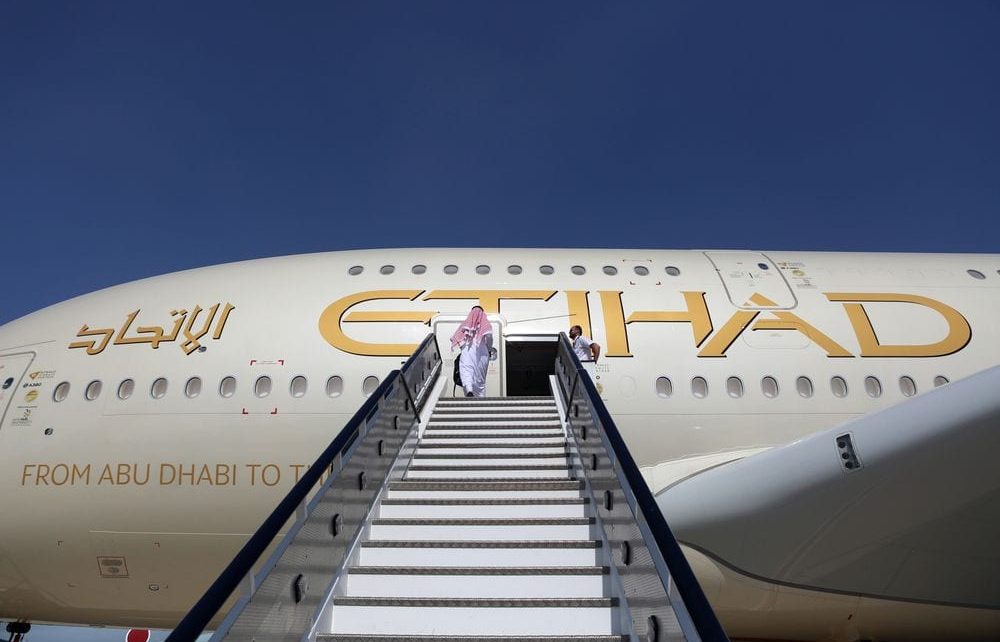COVID-19 shook the very foundation of the aviation industry, but Etihad stood firm and is ready to play a key role as the world returns to flying
- Etihad Airways carried 4.2 million passengers in 2020 with seat load factor of 52.9%
- Etihad Airways was the first airline in the world with 100% of operating flight crew vaccinated
- Prior to the pandemic, Etihad was ahead of transformation targets set in 2017, having registered a 55% cumulative improvement in core results by end-of-year 2019
Etihad Airways has announced its financial and operating results for 2020, recording a 76% fall in passengers carried throughout the year (4.2 million, compared to 17.5 million in 2019) as a result of lower demand and reduced flight capacity caused by the unparalleled global downturn in commercial aviation.
As a consequence of the COVID-19 pandemic and ensuing flight and travel restrictions, total passenger capacity was reduced by 64% in 2020 to 37.5 billion Available Seat Kilometers (ASKs), down from 104 billion in 2019, with the seat load factor declining to 52.9%, 25.8 percentage points lower compared to 2019 (2019: 78.7%).
The airline recorded US $1.2 billion passenger revenues in 2020, down by 74% from US $4.8 billion in 2019, due to fewer scheduled services and drastically fewer people traveling. A contributing factor to this was the total suspension of passenger services into and out of the UAE from end of March until early June 2020 to limit the spread of COVID-19, in line with a UAE government mandate. More than 80% of total passengers carried in 2020 were flown during the first three months of the year, demonstrating the precipitous drop in demand as the global crisis deepened over the course of the year.
The airline’s cargo operation, on the contrary, recorded an extremely strong performance, with a 66% increase in revenue from US $0.7 billion in 2019 to US $1.2 billion in 2020, driven by huge demand for medical supplies such as Personal Protective Equipment (PPE) and pharmaceuticals, paired with limited global airfreight capacity. Cargo yield saw an improvement of 77%.
Operating costs meanwhile decreased by 39% year-on-year, from US $5.4 billion in 2019 to US $3.3 billion in 2020, due to a combination of reduced capacity and volume-related expenses, as well as a focus on cost containment initiatives. Overheads reduced by 25% to US $0.8 billion (2019: US $1.0 billion) in this timeframe, despite their fixed nature, owing to cash and liquidity management initiatives during the crisis, while the finance cost reduced by 23% through an ongoing focus on balance sheet restructuring.
Overall, this resulted in a core operating loss of US $1.70 billion (2019: US $0.80 billion) in 2020, with the EBITDA turning to negative US $0.65 billion (2019: positive US $0.45 billion).
Prior to the pandemic, Etihad was ahead of transformation targets set in 2017, having registered a 55% cumulative improvement in core results by end-of-year 2019. This momentum continued into the start of 2020, with a record first quarter (Q1) that showed year-on-year improvement of 34%. The airline is continuing to target a complete turnaround by 2023, having accelerated its transformation plans and restructured the organization during the pandemic into a leaner and more agile business.
Tony Douglas, Group Chief Executive Officer, said: “Covid shook the very foundation of the aviation industry, but thanks to our dedicated people and the support of our shareholder, Etihad stood firm and is ready to play a key role as the world returns to flying. While nobody could have predicted how 2020 would unfold, our focus on optimizing core business fundamentals over the past three years put Etihad in good stead to respond decisively to the global crisis. We have taken bold action to protect our people and our guests, develop an industry-leading health and hygiene program, and restructure our business to better position us for recovery. As the world’s first airline to vaccinate all our operating pilots and cabin crew against COVID, we are ready to welcome back travelers to experience best-in-class travel with Etihad Airways.”
Adam Boukadida, Chief Financial Officer, said: “We started the year on a firm footing by surpassing our transformation targets for Q1 and were looking forward to a strong performance for the year ahead – and then the pandemic took hold. As passenger revenues nosedived, we took immediate action to secure Etihad’s long-term financial health, with a wide range of measures to mitigate the impact of Covid on our business. Despite significant pressures on our cash flow, we maintained liquidity by focusing on cost control, maximizing cargo revenue, enhancing our charter capabilities and raising innovative credit facilities such as the world’s-first sustainability-linked transition sukuk. This was supported by Etihad retaining an A with a ‘stable outlook’ credit rating by Fitch, making it one of a handful of airlines to maintain a pre-COVID rating.”
Summary of 2020 results:
| 2020 | 2019 | |
| Passenger revenue (US$ billion) | 1.2 | 4.8 |
| Cargo revenue (US$ billion) | 1.2 | 0.70 |
| Operating revenue (US$ billion) | 2.7 | 5.6 |
| EBITDA (US$ billion) | (0.65) | 0.45 |
| Core operating result (US$ billion) | (1.7) | (0.8) |
| Total passengers (million) | 4.2 | 17.5 |
| Available seat kilometres (billion) | 37.5 | 104.0 |
| Seat load factor (%) | 52.9 | 78.7 |
| Number of aircraft | 103 | 101 |
| Cargo tonnage (leg tonnes ‘000) | 575.7 | 635.0 |




